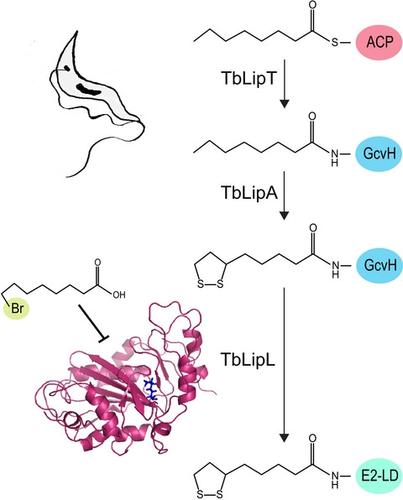当前位置:
X-MOL 学术
›
Mol. Microbiol.
›
论文详情
Our official English website, www.x-mol.net, welcomes your
feedback! (Note: you will need to create a separate account there.)
Functional characterization of the first lipoyl-relay pathway from a parasitic protozoan
Molecular Microbiology ( IF 2.6 ) Pub Date : 2022-04-28 , DOI: 10.1111/mmi.14913 Albertina Scattolini 1, 2 , Antonela Lavatelli 1, 3 , Paola Vacchina 1 , Daniel A Lambruschi 1 , María C Mansilla 1, 2 , Antonio D Uttaro 1, 2
Molecular Microbiology ( IF 2.6 ) Pub Date : 2022-04-28 , DOI: 10.1111/mmi.14913 Albertina Scattolini 1, 2 , Antonela Lavatelli 1, 3 , Paola Vacchina 1 , Daniel A Lambruschi 1 , María C Mansilla 1, 2 , Antonio D Uttaro 1, 2
Affiliation

|
Lipoic acid (LA) is a sulfur-containing cofactor covalently attached to key enzymes of central metabolism in prokaryotes and eukaryotes. LA can be acquired by scavenging, mediated by a lipoate ligase, or de novo synthesized by a pathway requiring an octanoyltransferase and a lipoate synthase. A more complex pathway, referred to as “lipoyl-relay”, requires two additional proteins, GcvH, the glycine cleavage system H subunit, and an amidotransferase. This route was described so far in Bacillus subtilis and related Gram-positive bacteria, Saccharomyces cerevisiae, Homo sapiens, and Caenorhabditis elegans. Using collections of S. cerevisiae and B. subtilis mutants, defective in LA metabolism, we gathered evidence that allows us to propose for the first time that lipoyl-relay pathways are also present in parasitic protozoa. By a reverse genetic approach, we assigned octanoyltransferase and amidotransferase activity to the products of Tb927.11.9390 (TblipT) and Tb927.8.630 (TblipL) genes of Trypanosoma brucei, respectively. The B. subtilis model allowed us to identify the parasite amidotransferase as the target of lipoate analogs like 8-bromo-octanoic acid, explaining the complete loss of protein lipoylation and growth impairment caused by this compound in T. cruzi. This model could be instrumental for the screening of selective and more efficient chemotherapies against trypanosomiases.
中文翻译:

寄生原生动物第一个硫辛酰中继途径的功能表征
硫辛酸 (LA) 是一种含硫辅因子,与原核生物和真核生物中枢代谢的关键酶共价连接。LA 可以通过清除获得,由硫辛酸连接酶介导,或通过需要辛酰基转移酶和硫辛酸合酶的途径从头合成。一个更复杂的途径,称为“硫辛酰中继”,需要两个额外的蛋白质,GcvH,甘氨酸切割系统 H 亚基,和一个氨基转移酶。迄今为止,在枯草芽孢杆菌和相关革兰氏阳性菌、酿酒酵母、智人和秀丽隐杆线虫中描述了该途径。使用酿酒酵母和枯草芽孢杆菌的集合在 LA 代谢缺陷的突变体中,我们收集到的证据使我们首次提出在寄生原生动物中也存在硫辛酰中继途径。通过反向遗传方法,我们将辛酰基转移酶和氨基转移酶活性分别分配给布氏锥虫的 Tb927.11.9390 ( TblipT ) 和 Tb927.8.630 ( TblipL ) 基因的产物。枯草芽孢杆菌模型使我们能够将寄生虫氨基转移酶鉴定为 8-溴辛酸等硫辛酸类似物的靶标,从而解释了这种化合物在T. cruzi中导致的蛋白质脂酰化完全丧失和生长障碍. 该模型可能有助于筛选针对锥虫病的选择性和更有效的化学疗法。
更新日期:2022-04-28
中文翻译:

寄生原生动物第一个硫辛酰中继途径的功能表征
硫辛酸 (LA) 是一种含硫辅因子,与原核生物和真核生物中枢代谢的关键酶共价连接。LA 可以通过清除获得,由硫辛酸连接酶介导,或通过需要辛酰基转移酶和硫辛酸合酶的途径从头合成。一个更复杂的途径,称为“硫辛酰中继”,需要两个额外的蛋白质,GcvH,甘氨酸切割系统 H 亚基,和一个氨基转移酶。迄今为止,在枯草芽孢杆菌和相关革兰氏阳性菌、酿酒酵母、智人和秀丽隐杆线虫中描述了该途径。使用酿酒酵母和枯草芽孢杆菌的集合在 LA 代谢缺陷的突变体中,我们收集到的证据使我们首次提出在寄生原生动物中也存在硫辛酰中继途径。通过反向遗传方法,我们将辛酰基转移酶和氨基转移酶活性分别分配给布氏锥虫的 Tb927.11.9390 ( TblipT ) 和 Tb927.8.630 ( TblipL ) 基因的产物。枯草芽孢杆菌模型使我们能够将寄生虫氨基转移酶鉴定为 8-溴辛酸等硫辛酸类似物的靶标,从而解释了这种化合物在T. cruzi中导致的蛋白质脂酰化完全丧失和生长障碍. 该模型可能有助于筛选针对锥虫病的选择性和更有效的化学疗法。









































 京公网安备 11010802027423号
京公网安备 11010802027423号